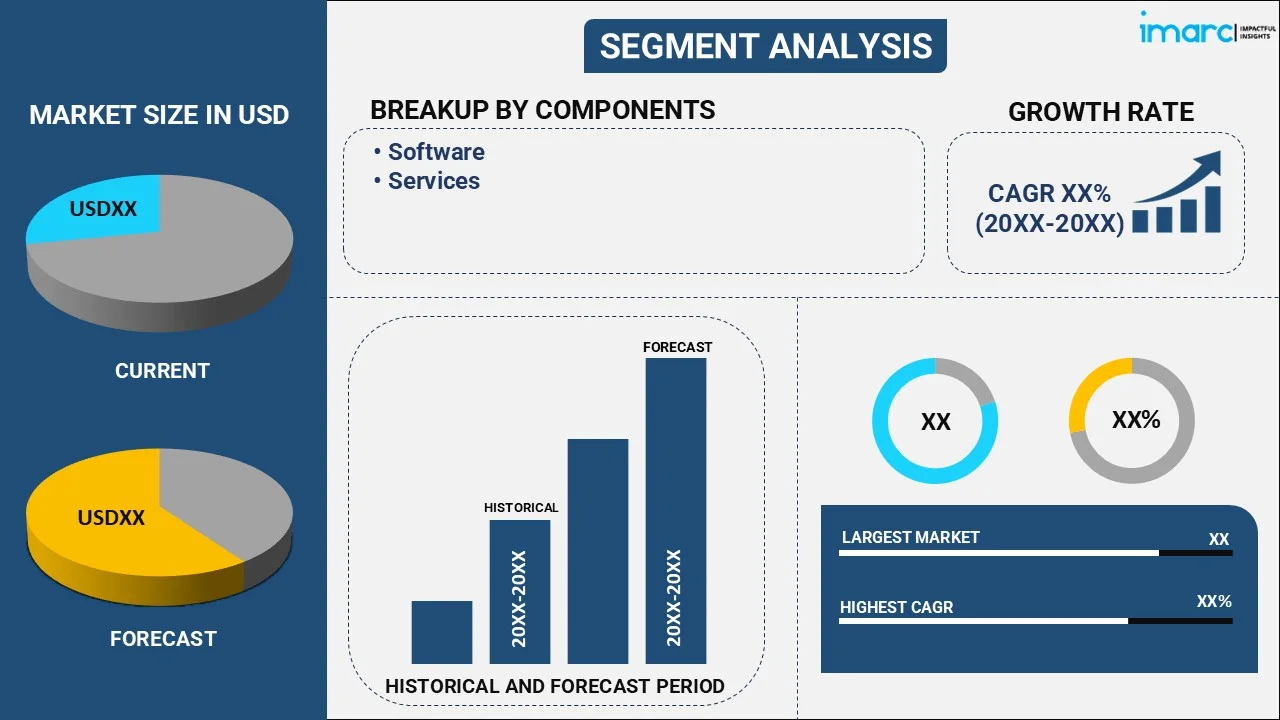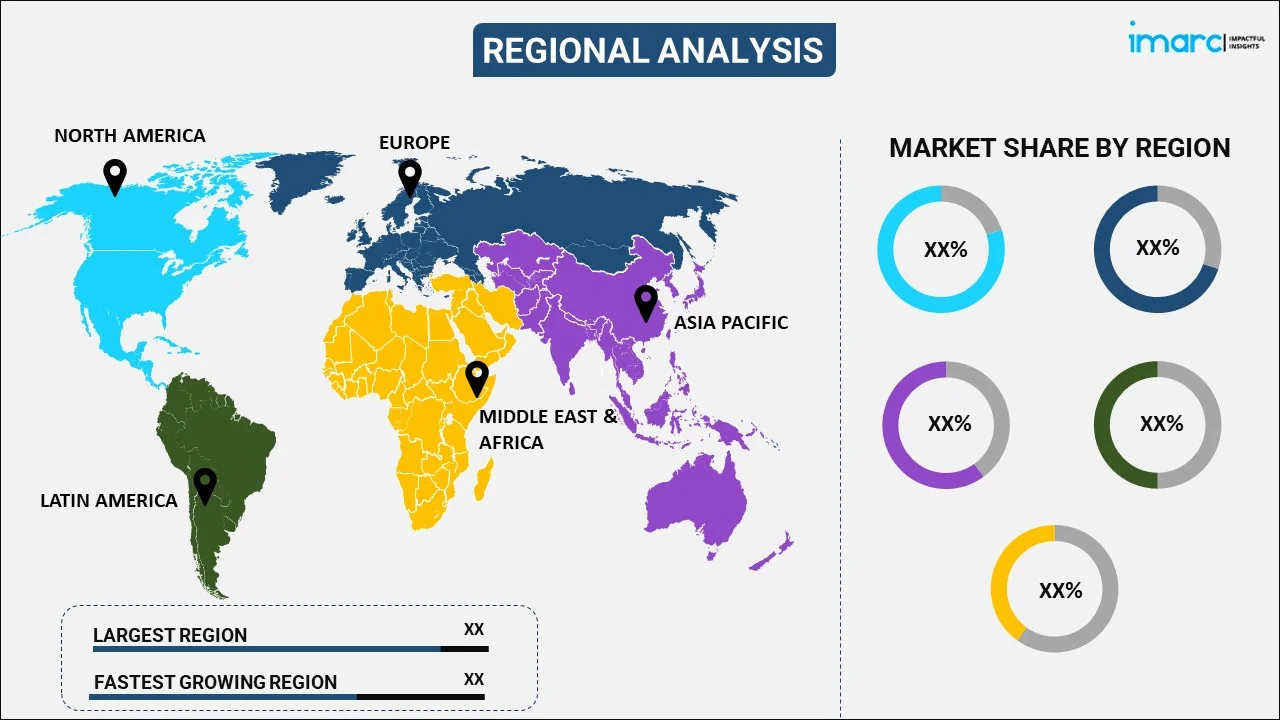
Aviation Analytics Market Report by Component (Software, Services), Deployment Mode (On-premises, Cloud-based), Business Function (Sales and Marketing, Finance, Maintenance, Repair and Operations, Supply Chain), Application (Flight Risk Management, Inventory Management, Fuel Management, Revenue Management, Customer Analytics, Navigation Services), End User (Airlines, Airports, and Others), and Region 2025-2033
Aviation Analytics Market Size:
The global aviation analytics market size reached USD 3.9 Billion in 2024. Looking forward, IMARC Group expects the market to reach USD 8.8 Billion by 2033, exhibiting a growth rate (CAGR) of 9.11% during 2025-2033. The global market is experiencing steady growth driven by the increasing demand for predictive maintenance, enhanced safety and security measures, the growing adoption of data-driven decision-making, and the rising need for operational efficiency and fuel optimization.
|
Report Attribute
|
Key Statistics
|
|---|---|
|
Base Year
|
2024
|
|
Forecast Years
|
2025-2033
|
|
Historical Years
|
2019-2024
|
|
Market Size in 2024
|
USD 3.9 Billion |
|
Market Forecast in 2033
|
USD 8.8 Billion |
| Market Growth Rate 2025-2033 | 9.11% |
Aviation Analytics Market Analysis:
- Major Market Drivers: Some of the major aviation analytics market growth drivers include the increasing demand for predictive maintenance, the rising emphasis on enhancing passenger experience, the growing adoption of data-driven decision-making, and the need for operational efficiency and fuel optimization.
- Key Market Trends: Key trends in the market include the development of sophisticated analytics platforms utilizing AI and machine learning, integration with IoT devices for better data accuracy, and strategic partnerships between analytics providers and aviation stakeholders to co-develop customized solutions.
- Geographical Trends: North America dominates the market, driven by the presence of major airlines, advanced technological infrastructure, and a high adoption rate of analytics solutions. The region's leadership is supported by substantial investments in aviation technology, early adoption of innovative analytics tools, and a regulatory environment that encourages data-driven decision-making.
- Competitive Landscape: Some of the major market players in the market include IBM, Capgemini SE, General Electric Company, SAS Institute Inc., SAP, and Honeywell. These companies focus on technological advancements and enhancing their service portfolios to expand their market presence and offer comprehensive support and consulting services for seamless implementation and optimization of analytics solutions.
- Challenges and Opportunities: Some of the challenges encountered in the market include data privacy concerns, the complexity of integrating diverse data sources, and the need for significant investment in technology and infrastructure. However, opportunities abound in the form of advancements in AI and machine learning, the growing adoption of IoT, and the increasing demand for real-time data insights and predictive capabilities to drive operational efficiency and enhance passenger experiences.
Aviation Analytics Market Trends:
Increasing demand for predictive maintenance
The aviation industry is witnessing a significant increase in the adoption of analytical solutions aimed at predicting equipment failures and maintenance breakdowns. This proactive approach is crucial for preventing disruptions and ensuring timely aircraft maintenance and downtime management. Utilizing big data and machine learning algorithms, aviation analytics enables the analysis of historical data and continuous real-time monitoring of aircraft components. This facilitates precise predictions regarding maintenance needs, thereby enhancing safety and reliability while significantly reducing maintenance costs. This trend is a key driver of growth in the global aviation analytics market. Additionally, it aids in optimizing operational efficiency by minimizing unexpected delays and cancellations. Airlines are increasingly recognizing the long-term cost benefits and operational improvements associated with predictive maintenance analytics.
Growing emphasis on enhancing passenger experience
There is a growing emphasis within the aviation sector on using analytics to improve the passenger experience. By leveraging data from passenger interactions, online bookings, in-flight experiences, and social media, airlines gain insights into passenger preferences, behavior, and responses. This information is used to offer targeted promotions, enhance in-flight facilities, streamline check-ins and boarding processes, and manage customer relations and loyalty programs more effectively. The heightened competition in the aviation industry has led to a focus on delivering superior passenger experiences, contributing to the development and adoption of aviation analytics. Furthermore, enhanced passenger experience leads to increased customer loyalty and brand reputation. As airlines continue to innovate, the use of analytics is becoming essential for staying competitive and meeting the growing expectations of travelers.
Increasing focus on operational efficiency and cost reduction
The aviation industry is constantly seeking ways to improve operational efficiency and reduce costs, which is a significant driver for the adoption of aviation analytics. Analytics solutions can help airlines in managing the fuel usage to identify the areas of savings as well as the flight procedures along with the route planning. The advanced knowledge of weather conditions, flight schedules, and airplane characteristics allows streamlining decisions that result in more efficient usage of fuel and timely arrivals. Additionally, it also enhances the crew scheduling and baggage-handling and airports, cutting costs to a very high extent. Due to the high level of competition faced in the aviation sector, advancements in analytics is inevitable in realizing operational efficiency and survival of the business.
Aviation Analytics Market Segmentation:
IMARC Group provides an analysis of the key trends in each segment of the market, along with forecasts at the global, regional, and country levels for 2025-2033. Our report has categorized the market based on component, deployment mode, business function, application and end user.
Breakup by Component:

- Software
- Services
Services accounts for the majority of the market share
The report has provided a detailed breakup and analysis of the market based on the component. This includes software and services. According to the report, services represented the largest segment.
The services segment holds the largest share of the market. This dominance is due to growing interest in consulting, integration and maintenance services, which facilitate implementation and enhancement of analytics solutions in the aviation industry. Since carriers and airports are seeking improvement of their operating efficiency and satisfaction of customers, they turn to reliable specialized service providers who are accommodating and analyzing significant amounts of information. Support services, including predictive maintenance, performance monitoring, and real time analysis are some of the services that need to be always provided and are expertise based. In addition, the highly developed pace of technology and the requirement for more special analytics services that is relevant in the aviation analytics industry market share is another major factor.
Breakup by Deployment Mode:
- On-premises
- Cloud-based
A detailed breakup and analysis of the market based on the deployment mode have also been provided in the report. This includes on-premises and cloud-based.
Breakup by Business Function:
- Sales and Marketing
- Finance
- Maintenance
- Repair and Operations
- Supply Chain
Finance represents the leading market segment
The report has provided a detailed breakup and analysis of the market based on the business function. This includes sales and marketing, finance, maintenance, repair and operations, and supply chain. According to the report, finance represented the largest segment.
The finance sector dominates the market as aviation organizations use analytics to understand passenger revenue management and cost distribution as well as profitability assessment for airlines and other companies. These companies use sophisticated financial analysis to pinpoint the right pricing discretion, fuel and other expense controls, and enhanced budgeting. Moreover, real-time processing of financial information is informative and enables sound decisions that improve operations and profitability. Also, financial analytics helps to solve some of the risks and oblige aviation companies to respect the rules and standards set up by governments and regulating bodies. The increasing focus on generating more revenues and reducing cost has focused the need on availability of the finance segment in the aviation analytics market.
Breakup by Application:
- Flight Risk Management
- Inventory Management
- Fuel Management
- Revenue Management
- Customer Analytics
- Navigation Services
A detailed breakup and analysis of the market based on the application have also been provided in the report. This includes flight risk management, inventory management, fuel management, revenue management, customer analytics, navigation services.
Breakup by End User:
- Airlines
- Airports
- Others
Airlines dominates the market
The report has provided a detailed breakup and analysis of the market based on the end user. This includes airlines, airports, and others. According to the report, airlines represented the largest segment.
Airlines accounts for the largest share of the market. This dominance can be attributed to the massive volumes of data airlines produce and their unique ability and imperative to leverage that information to improve operations and performance. Analytics is applied at the firm in several areas including maintenance, routes, fuel, and customers. The ability to get data from different areas including the flight operations, the customer feedback, and the booking systems allows the companies to implement decision making that is strategic and hence enhance efficiency and profitability. In addition, airline companies deal with high competition and operational issues thus must incorporate advanced analytics solutions.
Breakup by Region:

- North America
- United States
- Canada
- Asia-Pacific
- China
- Japan
- India
- South Korea
- Australia
- Indonesia
- Others
- Europe
- Germany
- France
- United Kingdom
- Italy
- Spain
- Russia
- Others
- Latin America
- Brazil
- Mexico
- Others
- Middle East and Africa
North America leads the market, accounting for the largest aviation analytics market share
The report has also provided a comprehensive analysis of all the major regional markets, which include North America (the United States and Canada); Asia Pacific (China, Japan, India, South Korea, Australia, Indonesia, and others); Europe (Germany, France, the United Kingdom, Italy, Spain, Russia, and others); Latin America (Brazil, Mexico, and others); and the Middle East and Africa. According to the report, North America represents the largest regional market for aviation analytics.
According to the aviation analytics market overview, North America leads the market, accounting for the largest aviation analytics market share. This can be attributed to the continual technological advancements, rising investments in aviation technology, and the expansion of airlines and analytics companies. Aviation analytics are becoming more commonplace among North American airlines as they apply this method to improve operations, passengers’ satisfaction, as well as security measures. Moreover, culture within healthcare settings to establish technology as a competitive advantage, the ability to regulate the market strongly, and government support for adopting technology are creating a positive market outlook. As a result, North America remains dominant in the aviation analytics market and contributes largely to its development.
Competitive Landscape:
The market research report has also provided a comprehensive analysis of the competitive landscape in the market. Detailed profiles of all major companies have also been provided. Some of the major market players in the aviation analytics industry include:
- Capgemini SE
- General Electric Company
- GrayMatter Software Services Pvt Ltd
- Honeywell International Inc.
- IGT Solutions Pvt. Ltd.
- International Business Machines Corporation
- Lufthansa Technik AG (Deutsche Lufthansa AG)
- OAG Aviation Worldwide Limited
- Oracle Corporation
- Ramco Systems Limited
- RELX Group plc
- SAS Institute Inc.
(Please note that this is only a partial list of the key players, and the complete list is provided in the report.)
Leading aviation analytics companies are focusing on investing on new technologies and collaboration agreements to improve their range of products and market share. IBM, SAP, Honeywell and several leading organizations are working to design smart solution that has provision of analytical AI, machine learning and big data for real time analysis and forecasting. These firms are also focussing to leverage their analytics solutions with IoT device to enhance the data accuracy and operational effectiveness. Furthermore, they are forging partnerships with airline and other aviation related companies to create end-to-end solutions tied specifically to users’ operations. In addition, key players are broadening their value proposition and providing end-to-end support and advisory services for complex analytics solutions’ adoption, implementation and usage, thus, enhancing customers’ satisfaction and loyalty levels.
Aviation Analytics Market News:
- On 21st June 2023, Capgemini SE and amazon web services (AWS) announced the launch of lifecycle optimization for aerospace. This platform aims at accelerating the adoption of circular economy practices in the aviation industry by automating the inspection process, optimizing lifecycle analysis of aircraft parts, and guiding decisions to extend their lifespan.
- On 2nd April 2024, General electric company completed its final planned divestiture, spinning off its energy business Vernova to become a standalone aviation company named GE aerospace.
- On 30th January 2023, Honeywell International Inc. launched a European clean aviation project that will develop a new generation of hydrogen fuel cells for the aviation industry. Project NEWBORN will involve multidisciplinary collaboration between 18 partners from 10 European countries to develop an aerospace-qualified megawatt-class fuel cell propulsion system powered by hydrogen.
Aviation Analytics Market Report Scope:
| Report Features | Details |
|---|---|
| Base Year of the Analysis | 2024 |
| Historical Period | 2019-2024 |
| Forecast Period | 2025-2033 |
| Units | Billion USD |
| Scope of the Report | Exploration of Historical Trends and Market Outlook, Industry Catalysts and Challenges, Segment-Wise Historical and Future Market Assessment:
|
| Components Covered | Software, Services |
| Deployment Modes Covered | On-Premises, Cloud-Based |
| Business Functions Covered | Sales and Marketing, Finance, Maintenance, Repair and Operations, Supply Chain |
| Applications Covered | Flight Risk Management, Inventory Management, Fuel Management, Revenue Management, Customer Analytics, Navigation Services |
| End Users Covered | Airlines, Airports, Others |
| Regions Covered | Asia Pacific, Europe, North America, Latin America, Middle East and Africa |
| Countries Covered | United States, Canada, Germany, France, United Kingdom, Italy, Spain, Russia, China, Japan, India, South Korea, Australia, Indonesia, Brazil, Mexico |
| Companies Covered | Capgemini SE, General Electric Company, GrayMatter Software Services Pvt Ltd, Honeywell International Inc., IGT Solutions Pvt. Ltd., International Business Machines Corporation, Lufthansa Technik AG (Deutsche Lufthansa AG), OAG Aviation Worldwide Limited, Oracle Corporation, Ramco Systems Limited, RELX Group plc, SAS Institute Inc., etc. |
| Customization Scope | 10% Free Customization |
| Post-Sale Analyst Support | 10-12 Weeks |
| Delivery Format | PDF and Excel through Email (We can also provide the editable version of the report in PPT/Word format on special request) |
Key Benefits for Stakeholders:
- IMARC’s industry report offers a comprehensive quantitative analysis of various market segments, historical and current market trends, market forecasts, and dynamics of the aviation analytics market from 2019-2033.
- The research report provides the latest information on the market drivers, challenges, and opportunities in the global aviation analytics market.
- The study maps the leading, as well as the fastest-growing, regional markets. It further enables stakeholders to identify the key country-level markets within each region.
- Porter's five forces analysis assists stakeholders in assessing the impact of new entrants, competitive rivalry, supplier power, buyer power, and the threat of substitution. It helps stakeholders to analyze the level of competition within the aviation analytics industry and its attractiveness.
- The competitive landscape allows stakeholders to understand their competitive environment and provides insight into the current positions of key players in the market.
Key Questions Answered in This Report
The aviation analytics market was valued at USD 3.9 Billion in 2024.
The aviation analytics market is projected to exhibit a CAGR of 9.11% during 2025-2033.
The aviation analytics market is driven by increasing demand for operational efficiency, safety, and cost reduction in the aviation industry. Advancements in data analytics, machine learning, and AI technologies enable predictive maintenance, fuel optimization, and route planning. Growing adoption of big data and IoT further fuels the market growth.
North America currently dominates the market driven by the continual technological advancements, rising investments in aviation technology, and the expansion of airlines and analytics companies.
Some of the major players in the aviation analytics market include Capgemini SE, General Electric Company, GrayMatter Software Services Pvt Ltd, Honeywell International Inc., IGT Solutions Pvt. Ltd., International Business Machines Corporation, Lufthansa Technik AG (Deutsche Lufthansa AG), OAG Aviation Worldwide Limited, Oracle Corporation, Ramco Systems Limited, RELX Group plc, SAS Institute Inc., etc.
Need more help?
- Speak to our experienced analysts for insights on the current market scenarios.
- Include additional segments and countries to customize the report as per your requirement.
- Gain an unparalleled competitive advantage in your domain by understanding how to utilize the report and positively impacting your operations and revenue.
- For further assistance, please connect with our analysts.

 Inquire Before Buying
Inquire Before Buying
 Speak to an Analyst
Speak to an Analyst
 Request Brochure
Request Brochure
 Request Customization
Request Customization




.webp)




.webp)












